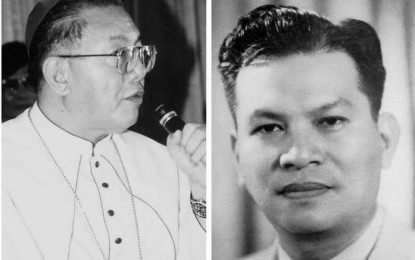Lifestyle
Nation marks birthdays of Magsaysay, Cardinal Sin Aug. 31

Manila Archbishop Jaime Cardinal L. Sin (left) and the late President Ramon F. Magsaysay. (Photos from Wikipedia via PNA)
MANILA — As the nation marks on Monday the 113th birthday of the late beloved President-statesman Ramon F. Magsaysay, the Filipino Catholics also observe the 92nd birth anniversary of the departed Manila Archbishop Jaime Cardinal L. Sin.
Monday is an official holiday nationwide as it coincides with the observance of National Heroes’ Day, which has been moved from the previous last Sunday of August of every year.
Magsaysay (1907-1957) was considered as the idol of the Filipino masses. Millions of Filipinos, young and old, cried and mourned when he died at the young age of 50 years in a plane crash on a mountain in Cebu on March 17, 1957.
The seventh president of the Philippines, Magsaysay was born in Iba, Zambales on August 31, 1907. He was elected to the presidency in November 1953, succeeding President Elpidio Quirino (1892-1956).
The annual Magsaysay Awards, Asia’s equivalent of the Nobel Peace Prize, was named in memory of Magsaysay.
Meanwhile, many of the Filipino people remember the late Cardinal L. Sin (1928-2005) for his important role in the historic and peaceful February 1986 EDSA People Power Revolution that ended the 20-year rule of former President Ferdinand E. Marcos.
Dubbed as the people’s revolt, aided by soldiers who rebelled against the Marcos government, on Feb. 22-25, 1986, it drove Marcos and his family out of Malacañang to Hawaii, where he died on Sept. 28, 1989 at age 72.
The administration of then President Corazon C. Aquino (1986-1992) refused to allow the repatriation of Marcos’ remains to the Philippines. It was only during the succeeding administration of President Fidel V. Ramos that the body of Marcos was brought back to Manila in 1993 and kept for several years at a refrigerated crypt in his home province of Ilocos Norte.
After President Rodrigo R. Duterte assumed office on June 30, 2016, he allowed the burial of the Marcos remains at the Libingan ng mga Bayani (Heroes’ Cemetery) in Taguig City on Nov. 18 of the same year.
The interment took place despite strong opposition from supporters and sympathizers of the Aquino family, as well as the so-called victims of the martial law which Marcos imposed on Sept. 21, 1972 to prolong his rule, which began on Dec.
30, 1965. The Supreme Court, voting 10-5, earlier allowed the Marcos burial at the Libingan.
Cardinal Sin, the 30th archbishop of the Roman Catholic Church of Metropolitan Manila and the third Cardinal of the Philippines, died on June 21, 2005 at the age of 77. He was buried at the Manila Cathedral Crypt in Intramuros.
While many people remember the late cardinal for his issuance of the historic call for Filipinos to support the soldiers who had rebelled against the Marcos dictatorship, he was admired mostly for his benevolence, being generous and an unselfish church leader who always thought of other people’s well-being and welfare before his own.
He showed these traits when he endorsed to then Pope John Paul II the creation of five new bishoprics or dioceses out of his Manila Archdiocese domain shortly before his official retirement at age 75 in 2003.
These dioceses were those of Novaliches and Parañaque, which were created in December 2002, followed by those of Cubao, Pasig and Caloocan in 2003.
The successive creation of the five new dioceses in Metro Manila in a span of one year clearly demonstrated the generous and unselfish attitude and willingness of the cardinal to sacrifice for the welfare of his people.
With the establishment of the dioceses of Cubao, Novaliches, Parañaque, Pasig and Caloocan, the formerly vast jurisdiction of the Manila Archdiocese under Sin was reduced to just the cities of Manila, Makati, San Juan, Mandaluyong and Pasay.
Normally, most leaders, whether of a local government unit (LGU) or a church bishopric, would not allow the reduction of their territorial jurisdictions. This is particularly true with government officials such as provincial governors, city or municipal mayors and barangay chairmen who are always against the partition of their respective territories.
This is because — particularly in the case of LGUs — a reduction of territorial jurisdiction would also mean lesser income for them in terms of internal revenue allotment or IRA.
The amount of an LGU’s IRA depends on income, land area and population.
The Novaliches Diocese was established on Dec. 7, 2002 and canonically erected by Pope John Paul II on Jan. 16, 2003 from its ecclesiastical province, the Archdiocese of Manila, which had territorial jurisdiction over the northern portions of the cities of Quezon and Caloocan.
According to the Diocese website, it has a jurisdiction area of 138 square kilometers, a dozen vicariates with over 70 parishes and churches at present — all emanating from the 164-year-old Parish and Shrine of Our Lady of Mercy located at the old town of Novaliches which was divided in 1948 between Quezon City and Caloocan, then still a municipality of Rizal province.
The seat of the diocese, which is dedicated to Jesus, the Good Shepherd, is located at Regalado Ave. Extension, Fairview, Novaliches. The current head of the diocese is Bishop Roberto O. Gaa.
On the other hand, the Diocese of Paranaque, also created in 2002, covers the adjacent cities of Parañaque, Las Piñas and Muntinlupa. It has a territorial jurisdiction of 126 square kilometers.
The Diocese of Cubao, erected on June 28, 2003, has jurisdiction over the southern half of Quezon City, mainly Districts I, III, and IV.
Meanwhile, the Diocese of Caloocan, also created in 2003, covers the southern half of Caloocan City as well as the cities of Malabon and Navotas.
The Pasig Diocese was also established in 2003 with jurisdiction over the cities of Pasig and Taguig as well as the town of Pateros





















